Snapshots From America’s Wars
-
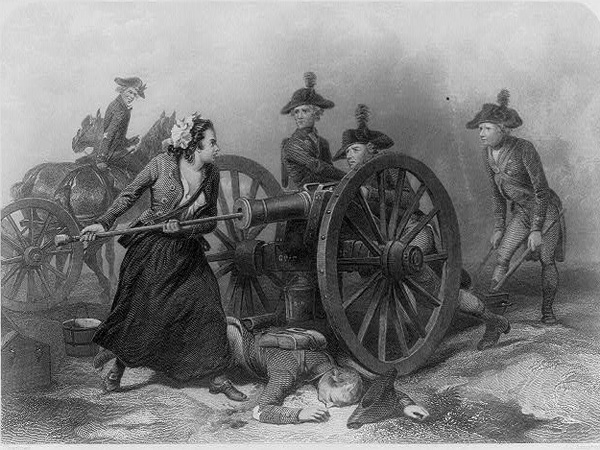 Library of Congress (PPOC).
Library of Congress (PPOC).This weekend, Americans will pause to remember the millions of men and women who’ve died serving their country. Here’s a look at the major conflicts that have taken American lives throughout our nation’s history.
Revolutionary War
Dates: 1775-1783
American soldier deaths: Approximately 25,000
Yankee heroine Molly Pitcher (aka Mary McCauley) loads a cannon during the 1778 Battle of Monmouth. In this pivotal Revolutionary War skirmish, Gen. George Washington led troops against the rear flank of the British army to eke out a victory for the Colonies. Temperatures that day topped 100 degrees, so both sides lost as many troops to heatstroke as they did to bayonet and gunpowder.
-
Wikimedia Commons.
Franco-American War
Dates: 1798-1800
American soldier deaths: 514
Relations between France and the United States soured when the United States patched things up with the British crown. In the throes of its own revolution and war with England, France resented America’s declaration of neutrality and began seizing U.S. trading ships. The never-declared Franco-American War (also dubbed the Quasi-War or the Half-War) prompted Congress to revive the country’s navy—although it was careful to authorize no more than 12 fighting vessels.
-
Library of Congress.
War of 1812
Dates: 1812-1815
American soldier deaths: approx. 20,000
Though it dwells mostly in the shadow of the Revolutionary War, the War of 1812 does have a special claim to fame: Its Battle of Baltimore (which took place in 1814) inspired Francis Scott Key’s “Star-Spangled Banner.” And the war had a salutary effect on U.S. politics as well. Americans were so thrilled to defeat Britain a second time that their partisanship dissolved into an “Era of Good Feelings.”
-
Library of Congress.
Mexican American War
Dates: 1846-1848
American soldier deaths: 13,283
Manifest destiny was the controversial, animating spirit behind 1846’s Mexican-American War—that, and the South’s desire to amass more territory for slave-owning. President Polk’s expansion efforts put him at odds with both Mexico and the U.S.’s own Whig party. Rep. Joshua Giddings, an opponent of slavery, famously slammed the campaign as “an aggressive, unholy, and unjust war.” In any case, it was bloody: a total of 13,283 American soldiers died, along with an untold number of Mexicans.
-
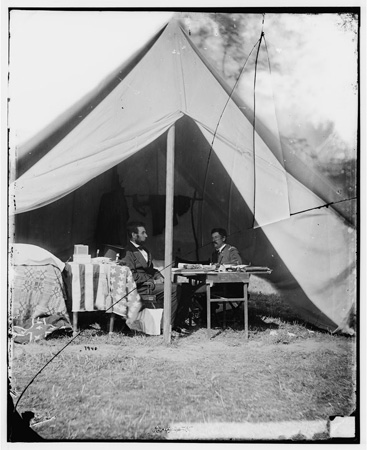 Library of Congress.
Library of Congress.Civil War
Dates: 1861-1865
American soldier deaths: approx. 625,000
President Lincoln and Gen. George B. McClellan confer in the general's tent on October 3, 1862.
-
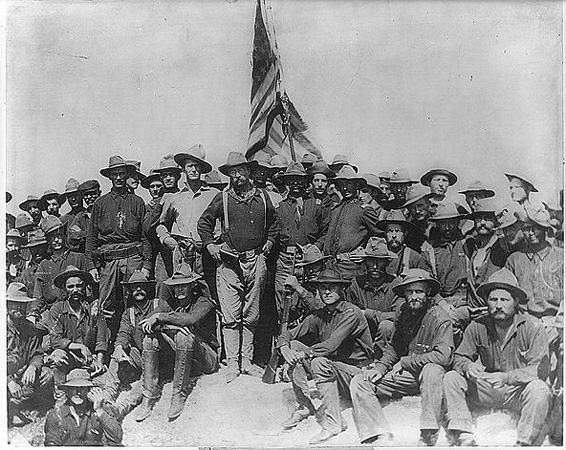 Library of Congress (PPOC).
Library of Congress (PPOC).Spanish-American War
Date: 1898
American soldier deaths: 2,456
Remember the Spanish-American War from history class? It was the one sparked by the mysterious sinking of a battleship, the U.S.S. Maine, in a Cuban harbor. Americans blamed the Spanish, who resented U.S. support for Cuba in the island nation’s struggle for independence. But the culprit could also have been an accidental fire or a rabble-rouser hoping to incite discord between America and Spain. The 10-week war cost 2,456 American lives (counting those who died from sickness and accidents as well as in the line of fire) but gave us Cuba, Puerto Rico, and the Philippines.This photo shows Teddy Roosevelt with his rough riders atop a hill they captured at the Battle of San Juan.
-
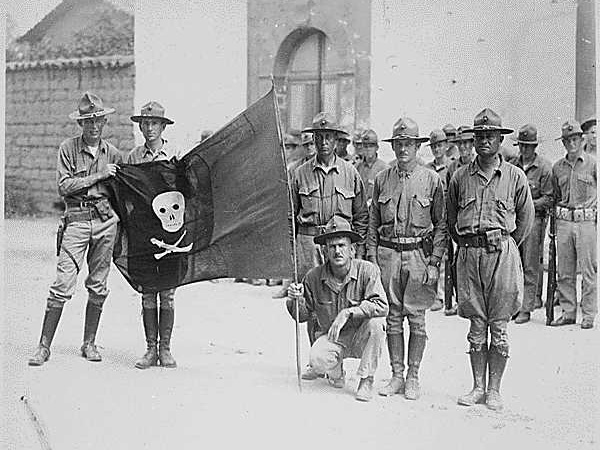 Wikimedia Commons.
Wikimedia Commons.Banana Wars
Dates: 1899-1901
American soldier deaths: 3,216
The Banana Wars consisted of a series of conflicts surrounding the United States’ presence in the Caribbean and Central America. Given the United Fruit Company’s strong commercial interests in banana farms, American lawmakers wanted to maintain their sphere of influence in what some called our “tropical empire.” This meant occupations, interventions, and police actions tendrilling into Cuba, Puerto Rico, Guatemala, Panama, Nicaragua, Haiti, Mexico, the Dominican Republic, and Honduras.
Here, U.S. Marines display the captured flag of Augusto Cesar Sandino in Nicaragua in 1932.
-
Credit: Archives/AFP/Getty Images.
World War I
Dates: 1914-1918
American soldier deaths: 116,708
The last living American veteran of World War I died last year, at the age of 110. The Allied Powers lost 9,407,136 soldiers and civilians to the fighting. The Central Powers lost 7,153,241—5 percent of their combined populations.
Correction, May 27, 2012: This caption originally stated that fewer than 25 living WWI veterans. No WWI veterans are alive today.
-
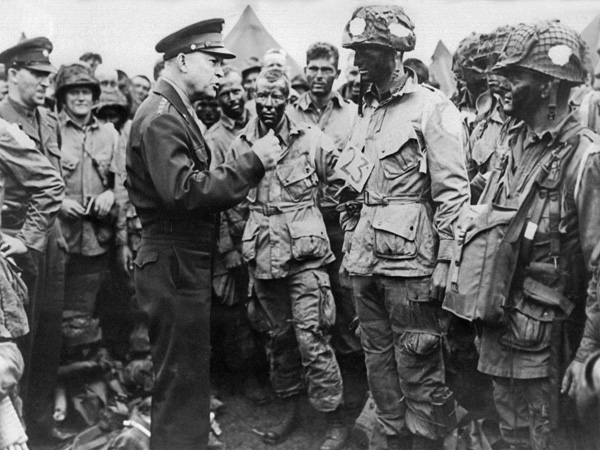 AFP/Getty Images.
AFP/Getty Images.World War II
Dates: 1939-1945
American soldier deaths: 407,316
An astonishing 16,535,000 American men fought in World War II. But the deadliest conflict in human history was also notable for its staggering civilian casualties, due to the Holocaust and the only use of nuclear weapons in warfare.
Here, Gen. Eisenhower instructs a group of paratroopers on the dawn of D-Day.
-
Chung Sung-Jun/Getty Images.
Korean War
Dates: 1950-1953
American soldier deaths: 54,246
The three-year Korean conflict exemplifies what military scientists call a proxy war: The direct combatants (North and South Korea) were really acting out tensions between dueling external powers (Communist China and the USSR on one hand, and the United Nations, particularly the United States, on the other). Official minutes from a meeting between President Truman and his top advisers on June 25, 1950, crystallize the situation:
"General Bradley said that we must draw the line [against Communist expansion] somewhere. The President stated he agreed on that. General Bradley said that Russia is not yet ready for war. The Korean situation offered as good an occasion for action in drawing the line as anywhere else."
Here, two South Korean soldiers re-enact a battle to celebrate the 60th anniversary of the victory over North Korea on Sept. 3, 2010.
-
AFP/Getty Images.
Vietnam War
Dates: 1960-1975
American soldier deaths: 58,168
The Vietnam War polarized the country and took 58,168 American lives. It marked the last time that the United States employed a draft. Every conflict since has used members of the all-volunteer military.
Here, a South Vietnamese soldier helps his wounded comrade through a ruined cemetary during the Tet Offensive in 1968. The Army of the Republic of Vietnam lost an estimated 266,000 troops over the course of the war.
-
Pascal Guyot /AFP/Getty Images.
Gulf War
Dates: 1990-1991
American soldier deaths: 293
Code-named Operation Desert Storm, the Gulf War cost the coalition $61 billion dollars, $12.8 billion of which came from the U.S. government. Of the 306,730 serving men and women, 396 earned Purple Hearts and 74 earned Silver Stars. This photograph shows a U.S. Army MP standing guard above his vehicle in Saudi Arabia.
-
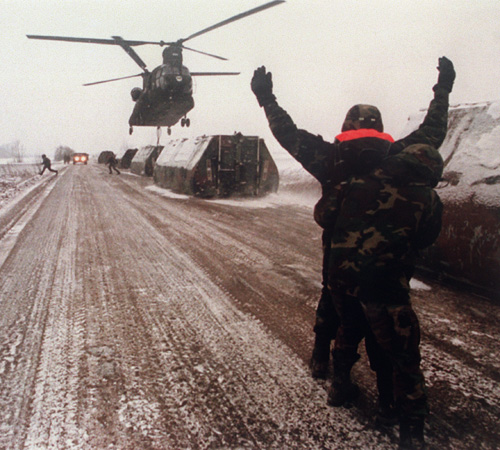 Mike Nelson /AFP/Getty Images.
Mike Nelson /AFP/Getty Images.Bosnia
Dates: 1995-1996
American soldier deaths: 12
NATO’s Operation Deliberate Force unleashed a series of airstrikes on the VRS, or Bosnian Serb Army, which menaced U.N.-designated “safe areas” in Bosnia during the Bosnian/Herzegovinian conflict. The campaign brought together troops from the United States, Turkey, Canada and most of Western Europe and resulted in 372 civilian deaths.
-
 USAF/Getty Images.
USAF/Getty Images.Kosovo
Dates: 1998-1999
American soldier deaths: 2
Called the first “humanitarian war,” the 78-day NATO campaign in Kosovo ended with a shaky truce between the ethnic Albanian army seeking independence and mother country Yugoslavia. Yugoslav military commander Milosevic vowed to protect the 2,000 cease-fire monitors who descended to keep the peace—yet he authorized only two pistols to do so.
-
Scott Olson/Getty Images.
Afghanistan
Dates: 2001-present
American soldier deaths: 1,538
A medic attached to the U.S. Army’s Task Force Shadow, charged with evacuating wounded soldiers and civilians from Southern Afghanistan, carries a marine hurt by an improvised explosive device. In 2011 alone, the U.N. Assistance Mission in Afghanistan reported 967 civilian deaths and 1,586 injuries from IEDs.
-
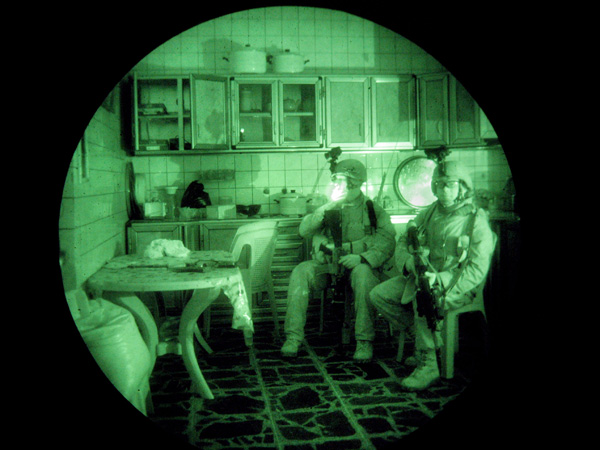 John Moore/Getty Images
John Moore/Getty ImagesIraq
Dates: 2003-2011
American soldier deaths: 4,454
Two U.S. Marines pause to smoke in the early hours of morning after a search and raid operation in a Ramadi household. The photograph was taken using night vision goggles. Though the United States has officially withdrawn from Iraq, nearly 50,000 military “advisers” remain—along with 85,000 contractors.